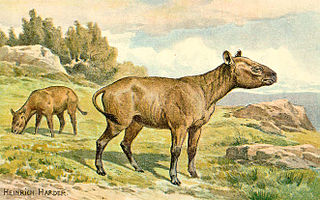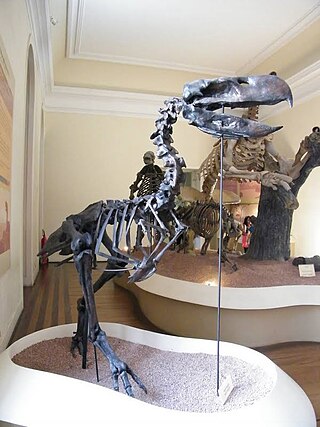
A passerine is any bird of the order Passeriformes which includes more than half of all bird species. Sometimes known as perching birds, passerines generally have an anisodactyl arrangement of their toes, which facilitates perching.
Pengana, also referred to as flexiraptor, is an extinct bird of prey that lived during the late Oligocene in what is now Queensland, Australia. It is known only from a fragment of the tibiotarsus that was collected from the Riversleigh World Heritage Area. The tibiotarsus is unusual in that it allowed for the leg to be swivelled backwards and sideways, making it well adapted to reaching into holes and crevices and extracting prey. The genus is only known from a single species, Pengana robertbolesi.

Palaelodus is an extinct genus of bird of the Palaelodidae family, distantly related to flamingos. They were slender birds with long, thin legs and a long neck resembling their modern relatives, but likely lived very different livestyles. They had straight, conical beaks not suited for filter feeding and legs showing some similarities to grebes. Their precise lifestyle is disputed, with researchers in the past suggesting they may have been divers, while more recent research suggests they may have used their stiff toes as paddles for swimming while feeding on insect larvae and snails. This behavior may have been key in later phoenicopteriforms developing filterfeeding bills. The genus includes between five and eight species and is found across Europe, Australia, New Zealand, Asia and possibly South America. However some argue that most of the taxa named from Europe simply represent differently sized individuals of one single species. Palaelodus was most abundant during the Late Oligocene to Middle Miocene periods, but isolated remains from Australia indicate that the genus, or at least a relative, survived until the Pleistocene.

Strigogyps is an extinct genus of prehistoric bird from the Middle Eocene to Early Oligocene of France and Germany. It was probably around the size of a large chicken or a guan, weighing not quite 1 kilogram (2.2 lb). Apparently, as indicated by the ratio of lengths of wing to leg bones, S. sapea was flightless. Its legs were not adapted to running, so it seems to have had a walking lifestyle similar to trumpeters. Unlike other Cariamiformes which appear to have been mostly carnivorous, the specimens of one species, Strigogyps sapea, suggest a facultatively herbivorous or omnivorous diet.

The Pelagornithidae, commonly called pelagornithids, pseudodontorns, bony-toothed birds, false-toothed birds or pseudotooth birds, are a prehistoric family of large seabirds. Their fossil remains have been found all over the world in rocks dating between the Early Paleocene and the Pliocene-Pleistocene boundary.

The Hyracodontidae are an extinct family of rhinocerotoids endemic to North America, Europe, and Asia during the Eocene through early Oligocene, living from 48.6 to 26.3 million years ago (Mya), existing about 22.3 million years.

Copepteryx is an extinct genus of flightless bird of the family Plotopteridae, endemic to Japan during the Oligocene living from 28.4 to 23 mya, meaning it existed for approximately 5.4 million years.

Paraphysornis is an extinct genus of giant flightless terror birds that inhabited Brazil during Late Oligocene or Early Miocene epochs. Although not the tallest phorusrhacid, Paraphysornis measured up to 1.4 metres tall at the hips and weighed around 180–240 kilograms (400–530 lb). It was also a notably robust bird, having short and robust tarsal bones not suited for pursuit hunting.
Eremopezus is a prehistoric bird genus, possibly a palaeognath. It is known only from the fossil remains of a single species, the huge and presumably flightless Eremopezus eocaenus. This was found in Upper Eocene Jebel Qatrani Formation deposits around the Qasr el Sagha escarpment, north of the Birket Qarun lake near Faiyum in Egypt. The rocks its fossils occur in were deposited in the Priabonian, with the oldest dating back to about 36 million years ago (Ma) and the youngest not less than about 33 Ma.

Juncitarsus is an extinct genus of wading birds from the Eocene of the United States and Germany. Though previously considered a flamingo, it is likely a stem-flamingo, possibly a relative of the group which contains both flamingos and grebes (Mirandornithes).

Bathornis is an extinct lineage of birds related to modern day seriemas, that lived in North America about 37–20 million years ago. Like the closely related and also extinct phorusrhacids, it was a flightless predator, occupying predatory niches in environments classically considered to be dominated by mammals. It was a highly diverse and successful genus, spanning a large number of species that occurred from the Priabonian Eocene to the Burdigalian Miocene epochs.
Phoenicopterus minutus is an extinct species of flamingo which inhabited California during the Late Pleistocene. It was originally discovered in San Bernardino County, California in the Lake Manix beds, where it coexisted with a second, larger flamingo species.
Phoenicopterus copei is an extinct species of flamingo that inhabited North America during the Late Pleistocene. Its fossils have been discovered in Oregon, California, Mexico and Florida. Many of these localities preserve the remains of juvenile individuals, indicating that this species nested at the lakes found there. In some areas like California and Florida it coexisted with smaller flamingo species. P. copei was a large species of Phoenicopterus, described as being greater in size than modern American flamingos.

Tonsala is an extinct genus of Plotopteridae, a family of flightless seabird similar in biology with penguins, but more closely related to modern cormorants. The genus is known from terrains dated from the Late Oligocene of the State of Washington and Japan.
Phoenicopterus stocki, also known as Stock's flamingo, is an extinct species of flamingo from the Pliocene of Chihuahua, Mexico. It was described in 1944 as a small bodied flamingo species known from assorted fragmentary remains, including bones of the tibia and the wings. The discovery of juvenile remains suggests that the locality where the fossils were found represents a shallow lagoon or mudflat that housed a breeding colony.
Phoenicopterus floridanus is an extinct species of flamingo that lived during the Pliocene in what is now Florida and potentially North Carolina.

Xenorhynchopsis is an extinct genus of flamingo from the Pliocene to Pleistocene Lake Eyre basin of Australia. Initially described as species of stork, the two known Xenorhynchopsis species are vastly different in size. X. minor is the older and small of the two species, ranging from the Pliocene to Pleistocene and being described as having reached a size smaller than that of the lesser flamingo. X. tibialis meanwhile appears to have been restricted to Pleistocene strata and was notably bigger, being counted as one of the biggest known flamingos in the fossil record.
Adelalopus is an extinct genus of palaelodid bird from the lowermost Oligocene of Belgium. It is the oldest member of its family and the largest known palaelodid from Europe, slightly larger than Megapaloelodus goliath. It contains a single species, Adelalopus hoogbutseliensis.

Klallamornis is an extinct genus of Plotopteridae, a family of large, flightless birds related to modern cormorants, darters, gannets, and boobies. This genus included the largest North American plotopterids. Its remains can be found in Late Eocene to Late Oligocene rocks from the Makah Formation, the overlying Pysht Formation and the Lincoln Creek Formation of the State of Washington. During its existence, Klallamornis was the largest plotopterid on the North American continent. The first fossil remains attributed to the taxon were collected in 1983, although the genus was not described until 2016.













